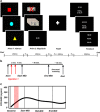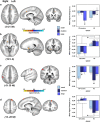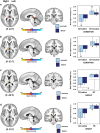Dissociable Effects of Cocaine Dependence on Reward Processes: The Role of Acute Cocaine and Craving
- PMID: 27545986
- PMCID: PMC5240179
- DOI: 10.1038/npp.2016.161
Dissociable Effects of Cocaine Dependence on Reward Processes: The Role of Acute Cocaine and Craving
Abstract
The relative impact of chronic vs acute cocaine on dependence-related variability in reward processing in cocaine-dependent individuals (CD) is not well understood, despite the relevance of such effects to long-term outcomes. To dissociate these effects, CD (N=15) and healthy controls (HC; N=15) underwent MRI two times while performing a monetary incentive delay task. Both scans were identical across subjects/groups, except that, in a single-blind, counterbalanced design, CD received intravenous cocaine (30 mg/70 kg) before one session (CD+cocaine) and saline in another (CD+saline). Imaging analyses focused on activity related to anticipatory valence (gain/loss), anticipatory magnitude (small/medium/large), and reinforcing outcomes (successful/unsuccessful). Drug condition (cocaine vs saline) and group (HC vs CD+cocaine or CD+saline) did not influence valence-related activity. However, compared with HC, magnitude-related activity for gains was reduced in CD in the left cingulate gyrus post-cocaine and in the left putamen in the abstinence/saline condition. In contrast, magnitude-dependent activity for losses increased in CD vs HC in the right inferior parietal lobe post-cocaine and in the left superior frontal gyrus post-saline. Across outcomes (ie, successful and unsuccessful) activity in the right habenula decreased in CD in the abstinence/saline condition vs acute cocaine and HC. Cocaine-dependent variability in outcome- and loss-magnitude activity correlated negatively with ratings of cocaine craving and positively with how high subjects felt during the scanning session. Collectively, these data suggest dissociable effects of acute cocaine on non-drug reward processes, with cocaine consumption partially ameliorating dependence-related insensitivity to reinforcing outcomes/'liking', but having no discernible effect on dependence-related alterations in incentive salience/'wanting'. The relationship of drug-related affective sequelae to non-drug reward processing suggests that CD experience a general alteration of reward function and may be motivated to continue using cocaine for reasons beyond desired drug-related effects. This may have implications for individual differences in treatment efficacy for approaches that rely on reinforcement strategies (eg, contingency management) and for the long-term success of treatment.
Figures




Similar articles
-
Neurofunctional Reward Processing Changes in Cocaine Dependence During Recovery.Neuropsychopharmacology. 2016 Jul;41(8):2112-21. doi: 10.1038/npp.2016.11. Epub 2016 Jan 21. Neuropsychopharmacology. 2016. PMID: 26792441 Free PMC article.
-
An initial study of neural responses to monetary incentives as related to treatment outcome in cocaine dependence.Biol Psychiatry. 2011 Sep 15;70(6):553-60. doi: 10.1016/j.biopsych.2011.05.008. Epub 2011 Jun 24. Biol Psychiatry. 2011. PMID: 21704307 Free PMC article.
-
Anticipatory reward processing among cocaine-dependent individuals with and without concurrent methadone-maintenance treatment: Relationship to treatment response.Drug Alcohol Depend. 2016 Sep 1;166:134-42. doi: 10.1016/j.drugalcdep.2016.07.006. Epub 2016 Jul 16. Drug Alcohol Depend. 2016. PMID: 27430401 Free PMC article. Clinical Trial.
-
Cocaine dependence: a disease of the brain's reward centers.J Subst Abuse Treat. 2001 Oct;21(3):111-7. doi: 10.1016/s0740-5472(01)00192-1. J Subst Abuse Treat. 2001. PMID: 11728784 Review.
-
Synaptic mechanisms underlying persistent cocaine craving.Nat Rev Neurosci. 2016 Jun;17(6):351-65. doi: 10.1038/nrn.2016.39. Epub 2016 May 6. Nat Rev Neurosci. 2016. PMID: 27150400 Free PMC article. Review.
Cited by
-
Impaired learning from punishment of errors in smokers: Differences in dorsolateral prefrontal cortex and sensorimotor cortex blood-oxygen-level dependent responses.Neuroimage Clin. 2019;23:101819. doi: 10.1016/j.nicl.2019.101819. Epub 2019 Apr 8. Neuroimage Clin. 2019. PMID: 31009885 Free PMC article.
-
Cocaine addicted rats show reduced neural activity as revealed by manganese-enhanced MRI.Sci Rep. 2020 Nov 9;10(1):19353. doi: 10.1038/s41598-020-76182-3. Sci Rep. 2020. PMID: 33168866 Free PMC article.
-
Mapping the Neural Substrates of Cocaine Craving: A Systematic Review.Brain Sci. 2024 Mar 29;14(4):329. doi: 10.3390/brainsci14040329. Brain Sci. 2024. PMID: 38671981 Free PMC article. Review.
-
The effects of age on reward magnitude processing in the monetary incentive delay task.Neuroimage. 2020 Feb 15;207:116368. doi: 10.1016/j.neuroimage.2019.116368. Epub 2019 Nov 16. Neuroimage. 2020. PMID: 31743790 Free PMC article.
-
dACC response to presentation of negative feedback predicts stimulant dependence diagnosis and stimulant use severity.Neuroimage Clin. 2018 May 9;20:16-23. doi: 10.1016/j.nicl.2018.05.007. eCollection 2018. Neuroimage Clin. 2018. PMID: 29989008 Free PMC article.
References
-
- Andres KH, von During M, Veh RW (1999). Subnuclear organization of the rat habenular complexes. J Comp Neurol 407: 130–150. - PubMed
-
- Breiter HC, Gollub RL, Weisskoff RM, Kennedy DN, Makris N, Berke JD et al (1997). Acute effects of cocaine on human brain activity and emotion. Neuron 19: 591–611. - PubMed
Publication types
MeSH terms
Substances
Grants and funding
LinkOut - more resources
Full Text Sources
Other Literature Sources
Medical

